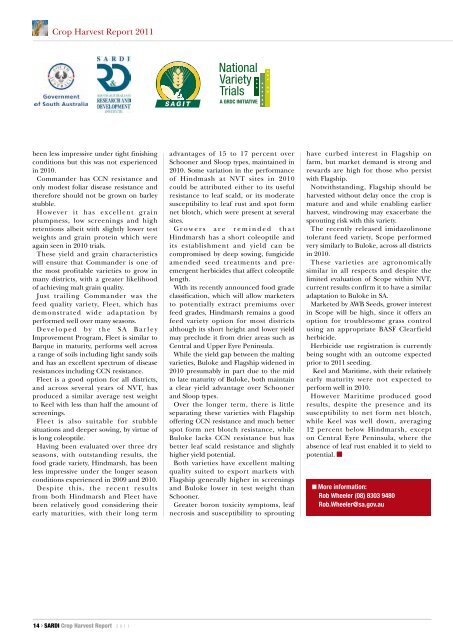Which varieties performed best? - Grains Research & Development ...
Which varieties performed best? - Grains Research & Development ...
Which varieties performed best? - Grains Research & Development ...
You also want an ePaper? Increase the reach of your titles
YUMPU automatically turns print PDFs into web optimized ePapers that Google loves.
Crop Harvest Report 2011been less impressive under tight finishingconditions but this was not experiencedin 2010.Commander has CCN resistance andonly modest foliar disease resistance andtherefore should not be grown on barleystubble.However it has excellent grainplumpness, low screenings and highretentions albeit with slightly lower testweights and grain protein which wereagain seen in 2010 trials.These yield and grain characteristicswill ensure that Commander is one ofthe most profitable <strong>varieties</strong> to grow inmany districts, with a greater likelihoodof achieving malt grain quality.Just trailing Commander was thefeed quality variety, Fleet, which hasdemonstrated wide adaptation by<strong>performed</strong> well over many seasons.D e v e l o p e d b y t h e S A B a r l e yImprovement Program, Fleet is similar toBarque in maturity, performs well acrossa range of soils including light sandy soilsand has an excellent spectrum of diseaseresistances including CCN resistance.Fleet is a good option for all districts,and across several years of NVT, hasproduced a similar average test weightto Keel with less than half the amount ofscreenings.Fleet is also suitable for stubblesituations and deeper sowing, by virtue ofis long coleoptile.Having been evaluated over three dryseasons, with outstanding results, thefood grade variety, Hindmarsh, has beenless impressive under the longer seasonconditions experienced in 2009 and 2010.Despite this, the recent resultsfrom both Hindmarsh and Fleet havebeen relatively good considering theirearly maturities, with their long termadvantages of 15 to 17 percent overSchooner and Sloop types, maintained in2010. Some variation in the performanceof Hindmash at NVT sites in 2010could be attributed either to its usefulresistance to leaf scald, or its moderatesusceptibility to leaf rust and spot formnet blotch, which were present at severalsites.G r o w e r s a r e r e m i n d e d t h a tHindmarsh has a short coleoptile andits establishment and yield can becompromised by deep sowing, fungicideamended seed treatments and preemergentherbicides that affect coleoptilelength.With its recently announced food gradeclassification, which will allow marketersto potentially extract premiums overfeed grades, Hindmarsh remains a goodfeed variety option for most districtsalthough its short height and lower yieldmay preclude it from drier areas such asCentral and Upper Eyre Peninsula.While the yield gap between the malting<strong>varieties</strong>, Buloke and Flagship widened in2010 presumably in part due to the midto late maturity of Buloke, both maintaina clear yield advantage over Schoonerand Sloop types.Over the longer term, there is littleseparating these <strong>varieties</strong> with Flagshipoffering CCN resistance and much betterspot form net blotch resistance, whileBuloke lacks CCN resistance but hasbetter leaf scald resistance and slightlyhigher yield potential.Both <strong>varieties</strong> have excellent maltingquality suited to export markets withFlagship generally higher in screeningsand Buloke lower in test weight thanSchooner.Greater boron toxicity symptoms, leafnecrosis and susceptibility to sproutinghave curbed interest in Flagship onfarm, but market demand is strong andrewards are high for those who persistwith Flagship.Notwithstanding, Flagship should beharvested without delay once the crop ismature and and while enabling earlierharvest, windrowing may exacerbate thesprouting risk with this variety.The recently released imidazolinonetolerant feed variety, Scope <strong>performed</strong>very similarly to Buloke, across all districtsin 2010.These <strong>varieties</strong> are agronomicallysimilar in all respects and despite thelimited evaluation of Scope within NVT,current results confirm it to have a similaradaptation to Buloke in SA.Marketed by AWB Seeds, grower interestin Scope will be high, since it offers anoption for troublesome grass controlusing an appropriate BASF Clearfieldherbicide.Herbicide use registration is currentlybeing sought with an outcome expectedprior to 2011 seeding.Keel and Maritime, with their relativelyearly maturity were not expected toperform well in 2010.However Maritime produced goodresults, despite the presence and itssusceptibility to net form net blotch,while Keel was well down, averaging12 percent below Hindmarsh, excepton Central Eyre Peninsula, where theabsence of leaf rust enabled it to yield topotential.More information:Rob Wheeler (08) 8303 9480Rob.Wheeler@sa.gov.au14 > SARDI Crop Harvest Report 2 0 1 1

















